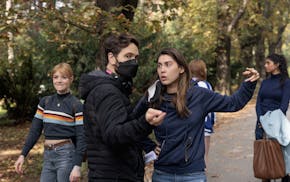Minnesota's most selective colleges enrolled increasingly diverse classes in the decade before the U.S. Supreme Court overturned affirmative action, a ruling that limits administrators' ability to consider race in admissions decisions.
But it will likely be years before college leaders have the data to know whether the controversial decision in June will undo that progress — or whether other recruitment techniques will attract students from a variety of backgrounds.
"I think the spirit of affirmative action was one of deliberately or intentionally building the future we wanted to see for the country," said Suzanne Rivera, president of Macalester College in St. Paul. "So the challenge we're facing now is how to continue advancing on that goal."
Both Macalester and Carleton colleges — the two most selective in the state — increased the percentage of students of color enrolling in their undergraduate programs between 2011 and 2021, according to a Star Tribune analysis of data compiled by the U.S. Department of Education. Still, the institutions remained predominantly white.
Similar trends played out on the University of Minnesota's Twin Cities campus, one of the largest public institutions in the state that considered race prior to this summer's court ruling.
Experts caution that it's difficult to determine how many of the diversity gains could be a result of affirmative action policies vs. other factors. In recent years, some schools have brought on additional recruiters or boosted programs for first-generation or low-income students. The country's demographics are also shifting, partly due to changes in birth rates years ago.
Affirmative action policies, which trace back to the civil rights movement of the 1960s, were designed to improve educational prospects for historically excluded groups, including women and people of color. For decades, courts ruled that colleges could consider race alongside other factors such as a student's grades, test scores, extracurricular activities or track record in leadership roles.
"Lots of those students could get in even without affirmative action," said Zachary Bleemer, an assistant professor of economics at Princeton University who studies affirmative action and university application processes. "So the challenge is figuring out which students, absent the affirmative action bump, would have gotten in anyway, and that's not directly observable. It's not like there's any mark on these applications."
Looking like America
Higher education leaders say there is no single metric for measuring whether affirmative action succeeded on Minnesota campuses. Colleges were legally barred from setting quotas based on race, and administrators interviewed for this story said they complied.
The University of Minnesota's Twin Cities campus increased the number of students it admits in recent years "because we thought we could serve more Minnesota students," said Robert McMaster, vice provost and dean of undergraduate education.
In 2020, nearly 30% of people who graduated from public high schools in Minnesota identified as people of color, according to data from the state Department of Education. That fall, about 26% of undergraduates on the Twin Cities campus described themselves as people of color, according to the federal data. The data doesn't include the racial breakdown for international students, who are counted in their own category.
McMaster said there was "not a target or a goal, just to be crystal clear." But looking back, the numbers tell him "that we were reflecting well the diversity in the high school class."
Selective schools like Carleton and Macalester — which accept less than a third of applicants — tend to recruit more nationally and internationally. "I think it would be wonderful if our colleges and universities looked like America," said Rivera, the Macalester president.
The most recent data from the U.S. Department of Education projected that in 2020 nearly half of all public high school graduates in the country would identify as people of color. That fall, nearly a third of undergraduates at Macalester and Carleton described themselves as people of color.
"We're proud of the progress we have made over the decade," said Alison Byerly, president of Carleton College. "We are looking to make increased progress."
Some students of color say they too see room for improvement.
Hatim Suliman helped form the Society of Black Men on the U's Twin Cities campus because he wanted to foster a sense of community and encourage Black men to contribute.
Suliman, 20, of Brooklyn Park, said he has noticed more students of color, but on a large campus that enrolls nearly 55,000 students, it can still take work to connect with people from similar backgrounds.
In the Carlson School of Management where he's enrolled, "it's not very common where I'll get more than three or four Black people in my classes," Suliman said. It's part of the reason he sought out Black student organizations in his freshmen year.
When Hailey Bates moved from her home outside of Chicago to Carleton College, in the mostly white town of Northfield, she noticed students self-segregating. She also noticed that many of the Black students had a different heritage than hers.
Bates' father is white, and her mother is African American, descended from enslaved people. Bates said many of the Black students she meets were born in Africa or have parents who were born on that continent.
"They come from a higher class than the vast majority, I would say, of African Americans do. Their parents are doctors and engineers. And they don't have the same generational ties to slavery and oppression that African Americans specifically face," Bates said.
Byerly, the Carleton president, said Bates makes "a perceptive point" — and one that hits on a theme often overlooked in the debate over affirmative action: the data on race doesn't always capture diversity within groups.
Awaiting guidance
Local college administrators say they've taken steps in recent years to increase diversity in many forms. "When we think about diversity, we have a big bucket," said McMaster, of the U, who noted they also consider factors such as geography, income and sexual orientation.
They also look for students with a variety of interests. "We want student athletes. We want poets. We want biology majors. We want students who can play in the orchestra," said Rivera, of Macalester.
The schools have worked to strengthen partnerships with community groups that help prepare students for college — and help connect them with students from a variety of backgrounds. Macalester has been highlighting its program that aims to cover students' financial needs. Carleton is looking at whether it can expand the geographic areas where it recruits as it works on a broader strategic plan.
When they were examining their diversity efforts, Byerly said administrators at Carleton College rarely stopped to try to decipher which of their gains stemmed from affirmative action vs. other programs.
"We very seldom talk about any one aspect of the admissions policies in and of itself," she said. "We see them as a package."
Local college leaders say they're hopeful many of the other tools they've built in recent years will help them continue to attract diverse students. But they're still awaiting official guidance from the U.S. Department of Education that should provide more clarity on what they can — and can't — do after the court's ruling.
"I think everybody is anxious," Byerly said. But, she added, the work administrators have done in recent years has left them "pretty well equipped to have these conversations at this moment in time."
Star Tribune Newsroom Developer Tom Nehil contributed to this story.
Rollover wreck of vehicle exiting I-94 in Minneapolis leaves 1 woman dead, 4 injured

Perfection comes with a reward for 3 teams in baseball Metro Top 10

Shakopee Mdewakanton tribe applies to put 815 acres in southwest metro into trust

Lakeville teachers vote to authorize strike

